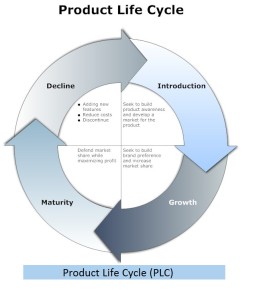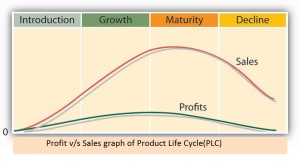In this article we are going to see what is product lifecycle and when & at what time does the life of product comes to an end. To have better life of product many companies opt for Product life cycle management. Product Life Cycle management(PLM) is the term mostly used in different companies such as IBM, Simens, Mphasis for developing the product right from its planning to its maintenance and support. Product Life cycle management is defined as the approach for developing product from its conception and idea, through design and manufacture, to service, maintenance and disposal.
Now let us come back to our original topic i.e. what is product life cycle? Every product has a lifecycle just like every human being has. Mainly there are four stages in lifecycle of product and these stages are-
1) Introduction stage- This is the first stage of product life cycle in which the idea for introducing product is developed. Many factors for launching product is considered such as market for introducing product which could be small, large or very large market. Other things that are considered are need of product in market, time for launching product, research and development cost, etc. Price of product is generally high in this stage of development.
2) Growth stage- In this stage sale of product is maximum and the product’s demand is rapidly growing in the market. As the sale and demand for product is maximum hence the profit that is earned during this stage will be maximum. There will be large investment in the product so that product will cover considerable amount of market.
3) Maturity stage- In this stage product has to compete with other products in the market and has to secure its position in market. Product has to undergo certain changes and modification so that it can maintain its position. Also some new version of product are released. Price of product starts declining and reaches to its minimum.
4) Decline stage- This is last stage in product life cycle. Demand for product in market will become less. Production volume of product in market will decline as the demand for product in market will become less. Customer of that product will switch to some other alternative which will be similar to that product and will have latest technology.
Let us consider example for life cycle sound recording-
1) Digital audio workstation or different software are introduced in market for recording. Also cell or smartphone have capability for audio recording and these product are in their introductory stage and are at the start of their lifecycle.
2) Digital recording- Digital recording can be done with the help of Digital Audio Tape or can also be done with compact disc. Digital audio Tape and compact disc are at the end of growth and begin of maturity stage and are facing lot of competition in market as more new technology are introduced daily in market.
3) Audio cassette- This audio cassette was introduced by Philips in 1963. This audio recording technique used reel to reel format for recording. It was very convenient method for audio recording and dominated other market products at that time.
4) Phonoautograph and gramophone- In the 19th century first phonautograph was invented and then the gramophone was invented. Both were mechanical device. The sound used to be captured by diaphragm and cutting needle. But now this device is not used in market and is in the decline stage of market. This is now outdated product and is mostly used as antique piece in house.

